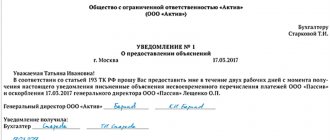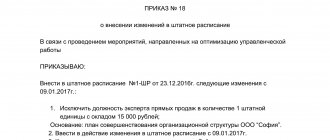An order to lift a disciplinary sanction is issued when the employee has fully served his disciplinary punishment, as well as in cases where the period of punishment has not yet expired, but for some reason the management of the organization decided to change their anger to mercy and cancel the previously imposed subject to personal sanctions.
- Form and sample
- Free download
- Online viewing
- Expert tested
FILES
Who is writing the document?
Any order is always issued on behalf of the head of the organization, but it can be drafted
- HR specialist,
- lawyer
- or company secretary.
Regardless of whose competence it is to write this document at a particular enterprise, it must be a person who has the necessary level of knowledge and education, knows the rules for drawing up this kind of internal orders, and is also familiar with the legislation of the Russian Federation in the field of labor and civil legislation.
Document execution algorithm
Let us remind you that there is no single form of order. You can arrange it yourself, but proceed according to the following scheme:
- Register your application in a special journal.
- Record the director's verdict in the form of a resolution.
- Draw up an order and have it endorsed by the director.
- Notify the employee about this.
Expert opinion
Mikhailov Evgeniy Alexandrovich
Teacher of civil law. Lawyer with 20 years of experience
While drafting the document, briefly and to the point, argue the reasons why it is necessary to cancel the penalty. For example, a sales manager can conclude a profitable contract, a lawyer can 100 percent win the case entrusted to him.
Sample
To cancel the sanctions, the culprit himself, his immediate supervisor or the team in which he works can contact the director of the company. It is necessary to submit an application requesting the liquidation of the foreclosure, indicating the motivated reasons for this.
You can also file a petition. It, like the statement itself, does not have a clear form, so it can be written in any form. Be sure to indicate the personal information of the person at fault and the reason for canceling the penalty.
Such documentation must be registered with the secretary. It is his number that will be used when drawing up the order.
If the director agrees with the arguments, then he creates an order to cancel the penalty. There is also no single form of order; organizations draw it up arbitrarily, but with the following information:
- Full name of the culprit and his position.
- Reasons for canceling sanctions.
- Date of cancellation.
- Personal information about the director and his signature.
The director is obliged to notify his employee of the new order.
Validity
A disciplinary sanction can be canceled automatically after one year. This is stated in article number 194 of the Labor Code of the Russian Federation. But if during this period the employee again violates labor discipline, then, at the request of management, he can be fired.
This is important to know: Sanatorium and resort treatment: how to get a free trip for pensioners
If, after the sanctions are lifted, the employee again violates the order, then such a mistake will still be considered primary, since the previous punishment is no longer in effect.
It is important to note that a person can even be fired under the article for repeated misconduct. Such a measure may subsequently cause serious problems in future employment.
If during the penalty period the employee moved to another position or to another department, then the punitive measures do not cease to be in force. Only dismissal can free an employee from punishment, since management will no longer be able to influence his professional activities.
Challenging
If the employee does not agree with the decision, he can appeal it to:
- Labor conflict commissions.
- Labor Inspectorate.
- Court.
A copy of the application must be left with the employee. It takes about thirty days to investigate the case. It is important to provide evidence that shows you are right. As a result of the check, there may be two possible solutions:
- Refusal to satisfy the claim.
- Request for the company to cancel the order to impose a disciplinary sanction.
Penalties for the company
If a positive conclusion is made in favor of the employee, the company undertakes to pay all the plaintiff’s costs of action. If a person was fired, he is reinstated. And during his absence from the workplace, he is entitled to compensation for absenteeism.
Types of disciplinary punishments
Based on the extent of the violation, the employee may be subject to different types of disciplinary action.
For example, being late for work may result in a written reprimand, but absenteeism twice without explanation can lead to dismissal. Punishment is also imposed for disclosure of confidential information and trade secrets, immoral behavior, violation of labor protection and safety rules, abuse of authority, etc.
Any types of disciplinary punishment (except, for obvious reasons, dismissal) can be canceled ahead of schedule. They are automatically withdrawn after a year.
Automatic cancellation
The expiration of the punitive measure means its automatic liquidation, which does not require official registration - the issuance of an order, as well as notification to the employee. For its occurrence, strict compliance with internal regulations throughout the entire period is necessary and, as a result, the absence of repeated penalties (clause 1 of Article 194 of the Labor Code of the Russian Federation).
According to labor law, the employee may be subject to disciplinary action. Find out what the deadline is for applying disciplinary action.
This is also important to know:
Who imposes a disciplinary sanction for violating sanitary legislation and what is the procedure for registration
Automatic withdrawal does not depend on the employee being at work or on vacation. This applies only to the first two types of disciplinary action: reprimands and reprimands; dismissal cannot be annulled.
A lifted penalty does not leave any consequences. Namely, it cannot be taken into account when an employee commits a new violation, which will be considered the first. At the same time, the use of incentive measures is resumed. For example, when calculating wages, bonuses and rewards begin to be taken into account again, or the interrupted countdown of time required to assign the next rank continues.
Automatic removal of a remark/reprimand for violation of labor discipline occurs if the employee does not repeatedly violate the set of internal rules of the enterprise within a year from the date of the issuance of the order of punishment.
What is the basis for issuing an order?
An order to lift a disciplinary penalty is justified for a variety of reasons. It could be
- personal decision of the director, who considered that the employee fully atoned for his guilt,
- request from the immediate supervisor of the employee subjected to reprimand,
- The trade union committee (if there is one at the enterprise) has the right to petition for the cancellation of the order.
- or the employee himself (in this case, a personal statement in writing is required).
It should be noted that such requests do not guarantee that the company’s management will accommodate the offending employee – in this case, the mutual consent of the parties plays a role.
Possibility of appealing against collection
A disciplinary sanction imposed on an employee can be challenged. So, according to Part 7 of Art. 193 of the Labor Code, in case of illegal issuance of a collection order, the employee may appeal to the labor inspectorate or the labor dispute commission. Also, an employee can always contact the prosecutor’s office to protect his rights.
The basis for an appeal may be the employer’s failure to comply with the procedure for imposing a penalty, the absence of the employee’s fault in what happened, or the discrepancy of the penalty in terms of the degree of responsibility and the degree of guilt of the employee.
Among the violations during the imposition of a penalty that can be easily challenged are the following:
- bringing an employee to several penalties for one offense;
- absence of a request from the employer to receive an explanatory note from the employee about the reasons for the misconduct;
- Violation of the deadlines for issuing an order : an order for collection must be issued within a month after the employer became aware of the misconduct, and no more than six months must have passed from the moment of the misconduct itself.
How to draw up an order to remove a disciplinary sanction
There is no unified, obligatory template for the removal of a disciplinary sanction, so companies can go two ways to formalize it: either draw it up in free form, or use a template developed within the enterprise (however, in this case it must be approved in the accounting policy firms). The order has a completely standard and understandable structure, which should include a number of necessary information:
- Name of the organization,
- personal data about the employee,
- date of compilation,
- information about previous penalties
- and the meaning of this order,
- as well as the persons responsible for its implementation.
Causes
The head of the organization can cancel the punishment ahead of schedule. The offending employee himself or his team may also ask for this. The reasons for canceling the penalty are as follows:
- Director's decision.
- The desire of the employee himself, described in the application.
- A written request coming from the immediate supervisor of the guilty person.
There is no single application form provided here. It is drawn up in any form, but it is important to take into account the following points:
- Personal data of the person to whom it is sent. Last name, first name and patronymic of the applicant.
- Request for early cancellation of foreclosure. You also need to indicate the full name of the culprit, the punishment, and the document on the basis of which the order was issued.
- Reasons why it is necessary to cancel the punishment.
- Signature of the applicant and date of preparation of the document.
It is on the basis of this letter that management will make a decision on whether to lift the penalty or refuse. If a positive decision is made, it must be formalized by an appropriate order.
How to place an order
The order can be written on a clean, empty A4 sheet or company letterhead, either by hand or in printed form (this does not matter, but the computer significantly speeds things up). In any case, the document must contain the original signature of the head of the company, as well as the autograph of the employee for whom the order was drawn up (thus the employee certifies that he has read the document). The order can be certified by a seal, but since 2016, the presence of a stamp or seal for legal entities is not a legal requirement.
Once the order is issued, the employee is deemed not to have been subject to discipline. All previously taken measures and restrictions in force in relation to it are cancelled.
The order is drawn up in a single copy and, after its acceptance, as a guide to action, it is sent for storage to the company’s archive, which contains the time established for such documents.
Drawing up an order to cancel the punishment
In a situation where the director independently decides to cancel the penalty, it is necessary to draw up an appropriate order. In all other cases, an application must be submitted. The order must be reviewed by the following persons:
- Employee.
- Applicant.
- HR department employee.
Expert opinion
Mikhailov Evgeniy Alexandrovich
Teacher of civil law. Lawyer with 20 years of experience
The cancellation of the punishment is entered in a special card T-2. It is also necessary to indicate the number and date of issue of the order. If, after the elimination of the penalty measure, the employee again violates discipline, then the canceled punishment cannot be extended. It is also not counted as a repeat violation.
Cases of early withdrawal
The Labor Code does not explain in any way why an employee can be released early from a previously imposed punishment. However, its 191st article specifies the basis on which the director has the right to reward an employee - for conscientious work at the enterprise. By analogy, this basis can be applied for early removal of foreclosure.
What is conscientiousness expressed in? The director's decision may be influenced by the following facts (in relation to the person being punished):
- work without complaints for a certain period;
- making rationalization proposals;
- plan overfulfilment;
- participation in community service;
- prevention of an accident or incident, etc.
Procedure
Article 194 of the Labor Code of the Russian Federation provides that after one year after the imposition of disciplinary punishment, it is removed automatically. The employee is considered not to have been held accountable.
Remember! To remove a penalty before the one-year period, you must:
- prepare a petition for its removal;
- enlist the support of your immediate supervisor;
- prepare an order to lift the disciplinary sanction;
- familiarize the employee with the order to remove the punishment from him.
Both the manager and the employee himself can take the initiative to lift the penalty early.
Important! If this is requested by the immediate superior, the head of the trade union, the general or trade union meeting, then they are obliged to justify their decision:
- improvement of labor performance;
- absence of violations of labor and production discipline;
- compliance with internal labor regulations;
- conscientious performance of their functional duties;
- other positive traits and qualities of the employee.
Based on the results of the consideration, the manager issues an order in which the previously imposed penalty is lifted from the offending employee. The indicated person is introduced to the order against signature. If the decision to lift the penalty was made by the court, then the order indicates that it was issued in pursuance of the court verdict. If we are talking about reinstatement at work, then the corresponding entry is made in the employee’s work book.
This is also important to know:
What is disciplinary action, in what cases is it applied?
Withdrawal procedure
The procedure for early withdrawal of foreclosure involves going through the following stages:
- The employer receives a request from the employee or another party to terminate the order early.
- The application is endorsed by the employer.
- An order is issued.
- The employee is introduced to the contents of the order upon signature.
Once the disciplinary sanction is lifted, the legal consequence of this will be that the employee will no longer be considered to have been subject to sanction, and subsequent references by the employer to the already lifted sanction will have no justification.
Grounds for cancellation of penalties
An employee has the right to early cancellation of a collection order under the following circumstances:
- conscientious work during the period of validity of the order;
- fulfillment of the established work plan beyond the norm;
- participation in the life of the team;
- identification and prevention of accidents and other violations;
- introducing rationalization proposals and new techniques.
If the employee has corrected himself, the following may intercede on his behalf: the head of the enterprise or organization, the employee himself, the head of the local trade union, a guarantor from the team, the boss of the punished employee himself. The initiator of the appeal must receive a link so that he can arrange a newsletter for recipients (Article 194 of the Labor Code of the Russian Federation). The employee must read the order to lift the penalty and sign.
Removal of foreclosure automatically
Removal of a disciplinary sanction in an automatic format does not imply any additional actions on the part of the employer in the form of issuing an order or making a note in a personal file.
The Labor Code takes precedence over other special laws and local regulatory legal acts.
The employer does not have the right to independently establish a longer period of validity of the penalty (even if he specifies such conditions in the collective agreement, they will be declared invalid). But individual laws may establish shorter time frames that improve the situation of employees.
For example, for employees of the Ministry of Internal Affairs, a reprimand is valid for a month, a severe reprimand is valid for a year. For military personnel, such a form of punishment as a severe reprimand entered into a personal file has also been established, and it is valid for a year.
Deadlines for imposing a penalty and familiarizing the employee with the order
Once a violation has been identified, the employer has a certain period to sort everything out and make a decision to bring the perpetrators to disciplinary action. Depending on the circumstances, the period for imposing a penalty should not exceed:
| Term | In which case |
| One month | In all cases where the culprits are at work. It is possible to perform a full internal investigation or audit. |
| Six months | If the worker who committed the violation is not at work (illness, long business trip, vacation). |
| Two years | If the fact of violation was discovered by an audit of economic activities. It is counted from the day the offense was committed, not its discovery. |
It should be taken into account that if, for reasons beyond the control of the employer (for example, the union deliberately delays the consideration of the administration’s appeal), the deadline for making a decision is postponed, this is not a gross violation.








